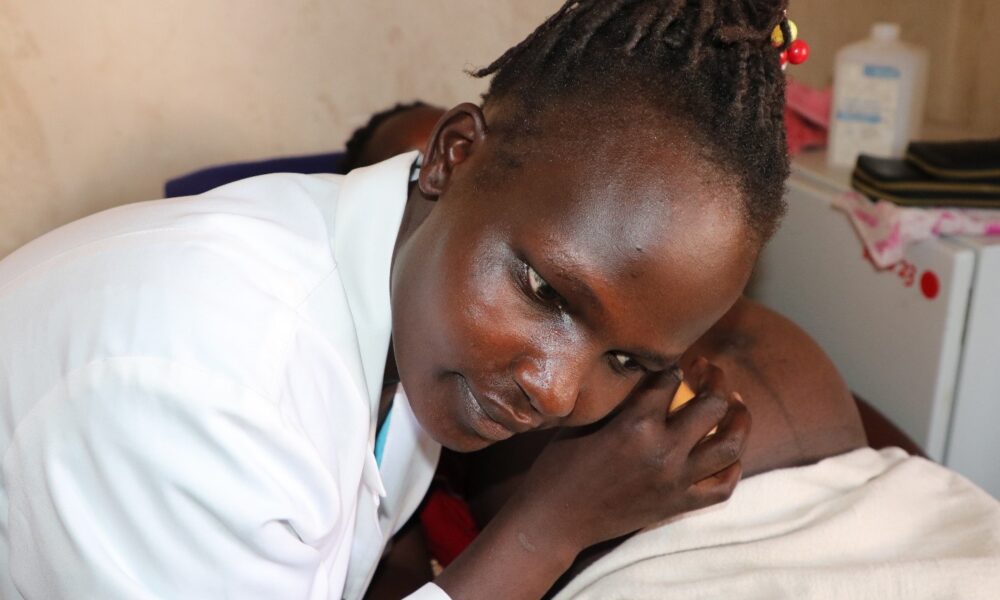By Philip Buda Ladu
As the globe marks “World Health Day 2025”, on July 7th, World Health Organization has revealed that South Sudan remains one of the countries with the highest maternal mortality rate globally.
According to WHO figures, the mortality ratio stands at 1,223 maternal deaths for every 100,000 live births.
Commemorated under the global theme “Healthy Beginnings, Hopeful Futures,” Dr. Humphrey Karamagi, the WHO Representative to South Sudan, highlighted the “unacceptably high” mortality rates and persistent systemic challenges hindering progress in this crucial area.
Dr. Karamagi echoed his concerns in a statement extended to the No.1 Citizen Daily Newspaper on the World Health Day commemoration underscoring the urgent need for action.
He emphasized that South Sudan stands at a “defining moment” in its pursuit of equitable health, with the situation for mothers and newborns demanding immediate and focused attention.
The W.H.O official paints a grim picture saying, South Sudan reports a staggering 1,223 maternal deaths per 100,000 live births, placing it among the countries with the highest rates globally.
The burden on newborns is equally severe, with 40 deaths per 1,000 live births and a stillbirth rate of 26 per 1,000.
Dr. Karamagi attributed these tragic outcomes to well-established barriers, including limited access to skilled care, low rates of facility-based deliveries, insufficient emergency obstetric services, and underutilization of vital reproductive health interventions.
Despite targeted investments, the proportion of births attended by trained health workers remains critically low at just 19 per cent. Furthermore, only a meagre 3 percent of health facilities are equipped to provide comprehensive emergency obstetric and newborn care.
Caesarean section coverage, a life-saving intervention for complicated births, accounts for a mere 1 per cent of expected births – far below the necessary threshold according to W.H.O statistics.
Dr. Karamagi also pointed out a significant drop-off in the continuum of maternal care stating “While over 60 per cent of pregnant women attend at least one antenatal care visit (according to 2024 DHIS2 data), less than half complete the recommended four visits, and only 15 per cent reach the WHO-recommended eight contacts.”
He added that this trend continues with facility-based deliveries, with less than half of those who started antenatal caregiving birth in a health facility. Alarmingly, only one in four mothers and newborns receive postnatal care within the critical first two days after birth.
However, the data also offers a glimmer of hope. Women who deliver in health facilities are significantly more likely to receive timely postnatal care, highlighting the protective effect of institutional deliveries.
Furthermore, antenatal care attendance shows a strong association with early newborn interventions, with 97.6 per cent of babies born to women who accessed antenatal care receiving the BCG vaccine.
The W.H.O. country representative highlighted that birth outcomes within health facilities also demonstrate the positive impact of skilled care, with higher rates of live births and substantially lower stillbirth and early neonatal mortality rates compared to national estimates.
Despite these positive indicators, preventable conditions such as preterm birth, neonatal sepsis, and birth asphyxia remain leading causes of complications, largely due to delayed or inadequate care, particularly in underserved rural areas.
Dr. Karamagi stressed that these service-level challenges are deeply intertwined with broader health system constraints.
While policy frameworks exist, their implementation is often hampered by coordination complexities. The health sector’s heavy reliance on external funding underscores the urgent need to strengthen domestic resource mobilization.
Gaps in the availability and distribution of skilled health workers, especially midwives and obstetricians, along with periodic stockouts of essential supplies, remain critical concerns.
Moreover, continued investment in health information systems is vital for timely decision-making and improved data utilization across all levels of care.
To accelerate progress and save lives, the WHO called for a “renewed collective focus on integrated maternal and newborn health.”
Key recommendations include: Strengthening national capacity for skilled birth attendance, Expanding access to comprehensive emergency obstetric and neonatal care, improving the availability of maternal and newborn commodities, and Advancing the use of the health information system (DHIS2).
Other are Institutionalizing the Maternal and Perinatal Death Surveillance and Response System, Increasing investments in maternal nutrition, education, and gender equity and Increasing the availability and uptake of modern contraceptives.
The WHO’s year-long campaign, “Healthy Beginnings, Hopeful Futures,” aims to urge governments and the health community to intensify efforts to end preventable maternal and newborn deaths and prioritize women’s long-term health and well-being.
A poignant recollection of Mrs. Atto Christine Lino, a midwife working in Juba, whose testimony was documented by WHO vividly illustrates the daily realities faced by mothers and healthcare workers in South Sudan.
“It is always a very painful experience, working with mothers and witnessing the immense pain they endure during childbirth, said Lino.
“Some manage to deliver safely despite the pain, others can lose their lives in the process,” she explains, adding that death is high among women who do not adhere to antenatal care.
Lino’s words highlight the immense pain women endure during childbirth and the tragic consequences for those who lack access to essential care, particularly those who do not attend antenatal care.
The global statistics underscore the magnitude of the challenge, with nearly 300,000 women dying annually due to pregnancy or childbirth-related causes and millions of newborns lost in their first month of life or stillborn, with the vast majority of these losses concentrated in low-income countries and fragile settings like South Sudan.
Dr. Karamagi’s statement serves as a powerful call to action for the government, partners, and the international community to prioritize maternal and newborn health in South Sudan and work collaboratively to secure a healthier and more hopeful future for its women and children.




